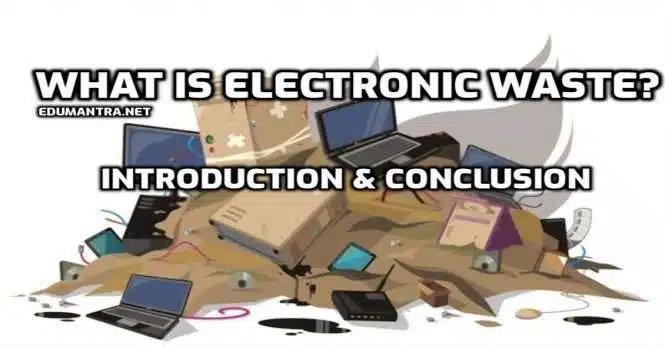
Electronic Waste: Introduction
The amount of electronic waste (paragraph on electronic waste) generated has been increasing recently, and the disposal methods have only gotten worse. Though some people are beginning to take measures to reduce their own environmental impact, it’s just not enough. Learn how you can personally help combat electronic waste pollution in this article!
What is Electronic Waste?
Electronic waste (environmental pollution) is any electronic equipment or material that is no longer needed and can be harmful to the environment. This includes old computers, printers, televisions, and other electronics.
Waste from electronic products contains harmful chemicals such as lead, mercury, and arsenic. These chemicals can pollute soil, water supplies, and ecosystems if they are not properly disposed of.
Electronic waste can also create safety hazards. Old electronics can contain dangerous wiring that may heat up when plugged in and create a fire hazard. Broken or malfunctioning electronics may also contain viruses or malware that could harm users or computers nearby.
There are many ways to reduce the amount of electronic waste created each year. Educating people about the dangers of improper disposal is key. Companies should also be encouraged to recycle their old products instead of putting them in landfills.
The Effects of Electronic Waste on the Environment
Electronic waste is a growing problem on our planet. it takes thousands of years for electronic waste to decompose and release harmful toxins into the environment. every year, millions of tons of electronic waste are generated and shipped to landfills and incinerators. this toxic waste contains lead, mercury, cadmium, polybrominated diphenyl ethers (PBDEs), and other hazardous substances.
Electronic equipment contains valuable materials that can be recycled if collected properly. however, many people in developed countries throw away their old electronics without thinking about their impact on the environment. this wastes valuable resources and increases the amount of pollution in the environment.
There are ways to reduce the amount of electronic waste that is produced. you can recycle your old electronics by taking them to a qualified recycling center. you can also try to reuse your old electronics by donating them or selling them online. if you cannot or do not want to recycle your electronics, you can dispose of them in an environmentally friendly way by using an electronic waste disposal service.
How To Prevent Environmental Pollution
Electronic waste (EW) is a growing problem on our planet. It’s hard to break down and contains harmful chemicals that can pollute our environment when it’s burned, recycled or dumped. In fact, electronic waste is the fastest-growing segment of the global waste stream.
There are many ways to reduce your personal contribution to electronic waste. You can recycle your electronics when you get the chance, use rechargeable batteries instead of disposable ones, and turn off your devices when you’re not using them. You can also help by urging businesses to take steps to reduce their use of electronic equipment and products.
Conclusion
The world is in the middle of a recycling crisis. We are not able to recycle enough materials to meet the demand of our rapidly growing economy and population. Not only is this creating mountains of waste, but it’s also harming our environment.
Electronic waste (e-waste) is a category that includes items such as computers, televisions, phones, tablets and other electronic equipment. It accounts for about 20 percent of all municipal solid waste (MSW), which is more than landfills and incinerators combined. E-waste
contains hazardous chemicals and metals that can leak into the environment if not properly disposed of. The improper disposal of e-waste can contaminate soil and groundwater with heavy metals like lead and arsenic. In some cases, these contaminants have been found at dangerous levels in surrounding populations.
There are many ways you can help reduce your e-waste footprint: by recycling what you can instead of disposing it in landfills or sending it overseas; buying products made with recycled material; choosing “green” electronics such as those that use less energy or biodegradable materials; disabling features when you don’t need them; taking steps to protect your